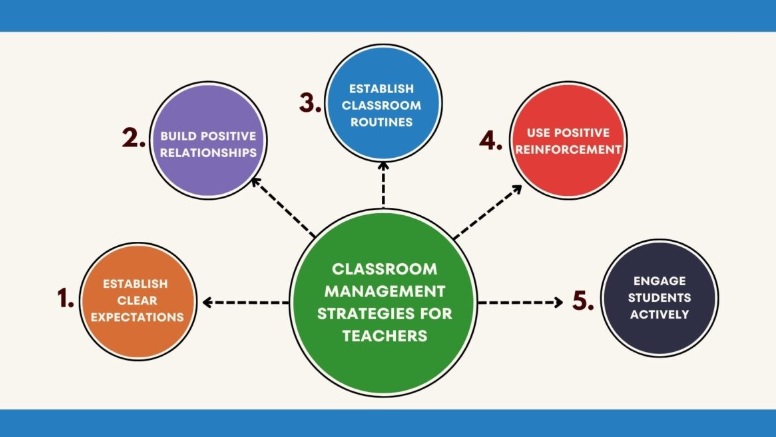10 Counseling Classroom Management Strategies Every Counselor Must Know About
30th July 2024
As part of their normal programming, school counselors spend a significant amount of time in the classroom imparting knowledge. Working with children in Pre-K through eighth grade will always be a hands-on experience for counselors, and the approaches to classroom management vary based on the grade level. Keep reading on to learn about a few tips for school counseling classroom management that have helped experts and can work for you too.
Counseling Classroom Management Strategies For Seamless Learning

Source: blog.tcea.org
These strategies might not work every single time, but when it does, they can make a world of difference in the way you deliver your lessons.
Take a look:
1. Have A Thorough Lesson Plan
You will be better able to foresee issues and organize the lesson around the time allotted if you have a pre-planned hook, instructional technique, demonstration, and practice exercises. Consider the pupils' movements, where they will sit, and what they will require. This will eliminate any misunderstandings or time wastage during the class.
Do you follow us on Social Media? If not, then you’re missing out on a lot of informative content. We regularly share upgraded educational content, tips, feedback, and more. Check us out by clicking the profiles here - Facebook / Twitter / LinkedIn / Pinterest / Instagram / YouTube
2. Establish Routines
Establish routines for both yourself and your pupils. Changing up the game each time you meet your pupils is a certain way to cause turmoil. Perhaps you extend a warm greeting or do a breathing technique first. Perhaps they are aware that they will have five minutes to contribute at the end. Give them definite schedules so they will know what to expect. It's consoling to know what to anticipate.
3. Greet Students By Name
Building relationships with each kid individually takes three minutes, and this is the most important aspect of classroom management. Give pupils a high five or fist bump at the entrance when they arrive in your classroom and state their names.
4. Show Genuine Enthusiasm
Show your pupils how excited you are about the topic you are studying and your time together, even if it may seem obvious. They are more inclined to be invested when they observe your level of investment.
5. Begin Or End With A Calming Strategy
Put this one under ‘thorough lesson plan,’ but a soothing technique at the start of a class is a tried-and-true method to control or stop certain behaviors. At the start of the class, lead your pupils in a quick yoga stretch or mindfulness activity to help them relax and focus. Alternatively, finish your session with a relaxing exercise if you're teaching a high-energy class with plenty of movement.
6. Set Clear Expectations
Before beginning any session, establish clear standards regarding student behavior. ‘I need all eyes on me and hands in laps while I show you this breathing exercise,’ or ‘Show me how you will sit and look while I read the book.’ Even though they might seem like common sense, outlining them in detail beforehand might assist students who need reminders to avoid making little mistakes.
7. Give Clear Non-Verbal Clues
Give a discreet hand gesture or other non-verbal message to pupils who are not adhering to your expectations for their conduct initially. Rather than confronting the kid in front of others, if the conduct persists, have a brief private conversation with the student to go over the expectations.
8. Use Proximity
One usual tactic is to move closer to a student who is not behaving according to expectations; however, consider moving around more often, rather than simply when anything goes wrong. Increased attention is generated when you stand still in front of the class and then quickly approach a pupil who is not paying attention. Instead of only moving when there is an issue, try moving about the classroom the entire time. As they follow your movements, it also maintains their interest.
9. Manage Interruptions
Use hand gestures that are nonverbal to handle these disruptions. If a student has to go to the bathroom, they can give you a 1, if they need a tissue, a 2, if they have a question, or a 4, if they want to share. When you see a two, you don't have to stop what you're doing or change the subject to discreetly indicate to the student and the tissues. Although it takes a lot of effort, students will find that it significantly reduces interruptions once they get the hang of it!
10. Give Short And Clear Directions
Similar to expectations, instructions must be very explicit. And frequently, simply pointing or providing instructions is insufficient. Before letting pupils practice on their own, try providing instructions and having them practice with you two or three times.
Manage Classroom Better
There is no such thing as ideal classroom management; instead, it is a process of learning by doing and improving. Even though the majority of school counselors are not trained in classroom management, everyone can learn and get better. Additionally, you can also enroll yourself in a Post Graduate Diploma in Counselling for Teachers for better management strategies.
We believe education should be accessible to everyone. That’s why we don’t charge for our blogs. Find the right course that will help you in your career. Contact us at - 1800–212–6400. You can mail us at act@asiancollegeofteachers.com.
Written By : Sanjana